

— Blogs —
—Products—
 Consumer hotline +8618073152920
Consumer hotline +8618073152920 WhatsApp:+8615367865107
Address:Room 102, District D, Houhu Industrial Park, Yuelu District, Changsha City, Hunan Province, China
Product knowledge
Time:2024-10-24 16:08:25 Popularity:1268
- Principle of operation: this sensor determines the humidity by measuring the impedance of the soil to the current. When the soil humidity increases, the conductivity of the soil increases, the resistance decreases; conversely, the resistance increases.
- Principle of operation: capacitive sensors use the characteristics of the soil dielectric constant changes with humidity to measure humidity. When humidity increases, the dielectric constant of the soil increases, resulting in a rise in capacitance.
- Principle of operation: FDR sensors infer humidity by measuring the reflectivity of the soil to electromagnetic waves. The higher the soil moisture, the lower the reflectivity.
- Principle of operation: TDR sensors determine soil moisture by sending electromagnetic pulses and by measuring the pulse propagation time through the soil. The higher the humidity, the longer the pulse propagation time.
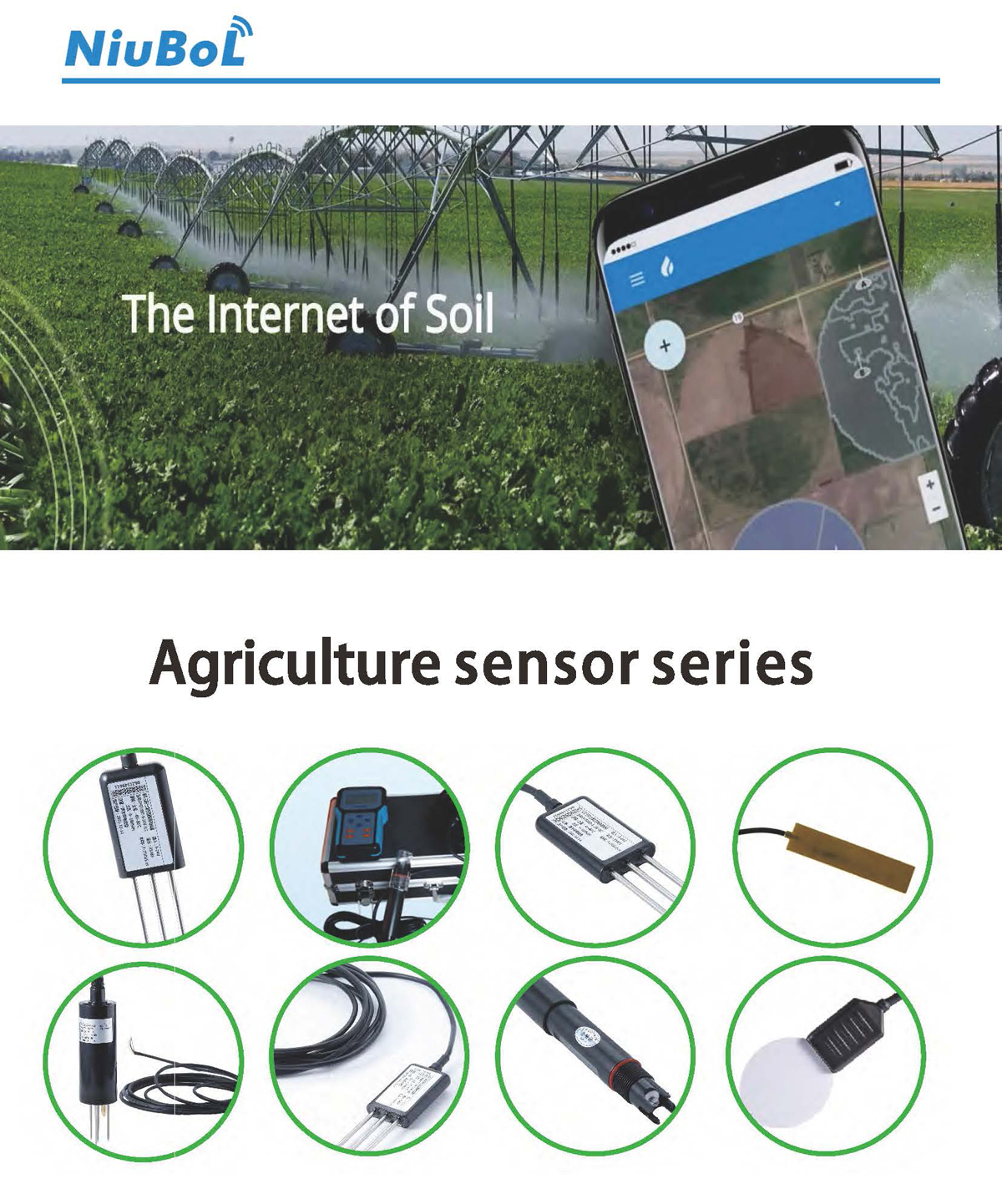
1. High-precision measurement: it can measure the soil moisture content in real time, continuously and accurately, and is not affected by soil type, temperature change and other factors.
2. good stability: long-term use is not easily affected by changes in the soil environment.
3. strong anti-interference ability: in complex soil conditions can still maintain good measurement performance.
4. Durability: Adopting anti-corrosion materials to adapt to various harsh environments.
5. Easy to install and maintain: simple design, easy for farmers to operate.
6. Intelligent perception and feedback: usually with intelligent functions, it can be used with supporting equipment to send real-time monitoring data to the environmental monitoring cloud platform, which is convenient for users to view and manage remotely.
7. Flexible configuration and scalability: according to the needs of different agricultural production scenarios, it can be integrated with other types of sensors (e.g., temperature, light, EC value sensors, etc.) to build a comprehensive soil environment monitoring system.
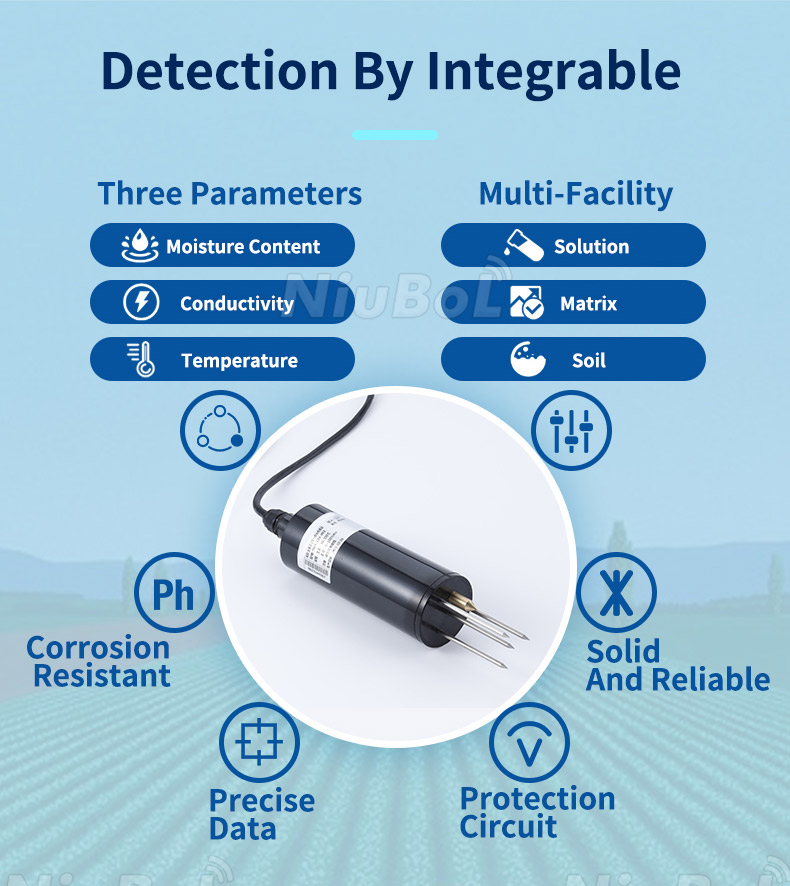
1. Precise irrigation: According to the real-time data of soil moisture, automatically adjust the irrigation system to avoid excessive or insufficient irrigation.
2. Water saving and yield enhancement: Reduce water waste by optimising water management, while improving crop quality and yield.
3. Environmental Adaptation: Monitor the water demand of different crops, adapt to various soil conditions and achieve personalised management.
4. Scientific research: Provide accurate soil moisture data for agricultural scientific research to support the breeding of new varieties and the improvement of cultivation techniques.
5. Environmental protection: Reduce the waste of water resources and soil salinisation caused by excessive irrigation, prevent the loss of fertilizers and pesticides with water, and protect water quality.
6. Cost-effectiveness: Reduce unnecessary irrigation costs and possibly reduce crop losses due to improper water management.
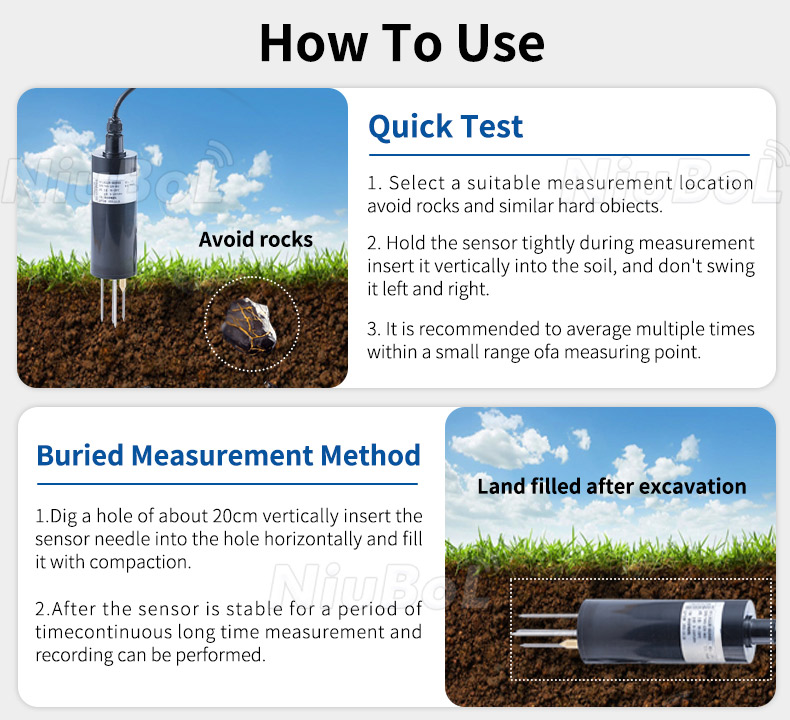
1. Choose a suitable location: should be installed in the crop root activity layer, avoid installation in the tree roots, rocks and so on.
2. Avoid interference: Keep away from large metal objects and power lines to reduce electromagnetic interference.
3. Correct burial: Buried at the required depth according to the instruction manual to ensure that the sensor is in full contact with the soil. Usually at least 30cm deep to reflect the moisture condition of crop roots.
4. Vertical Installation: Insert the sensor vertically into the soil and make sure the probe is parallel to the ground to minimise errors.
5. Full insertion: Make sure the probe is fully embedded in the soil to reduce operating errors and improve measurement accuracy.
6. Backfill and compaction: After installation, the soil should be backfilled and gently compacted, and watered appropriately to maintain the natural state of the soil.
7. Protect the cable: Avoid damage to the cable, do not pull or bend it excessively to ensure the stability of signal transmission.
8. Regular calibration: Calibrate the sensor regularly according to the usage conditions to ensure the accuracy of measurement.
9. Environmental adaptation: Considering the soil type and environmental conditions, it may be necessary to adjust the installation method to adapt to different situations.
1. Real-time monitoring: provide real-time soil moisture data for crop growth.
2. Precision management: adjust the irrigation plan according to the soil humidity, to achieve precision agriculture management.
3. Data accumulation: accumulate long-term soil moisture data to provide decision support for agricultural production.
4. Improve crop yield: Reasonable management of water to ensure that crops grow under optimal water conditions, thus improving yield and quality.
5. Water saving and energy saving: Reduce unnecessary irrigation, save water resources and reduce energy consumption.
6. Disease reduction: Excessively wet soil is a breeding ground for many diseases, and precise control of moisture helps to reduce the incidence of diseases.
7. Environmental adaptability: Adjusting irrigation strategies according to different crops and seasonal changes enhances the ability of crops to adapt to environmental changes.
8. Cost-effectiveness: In the long run, it reduces the cost of agricultural production by reducing the excessive use of water and fertilisers.
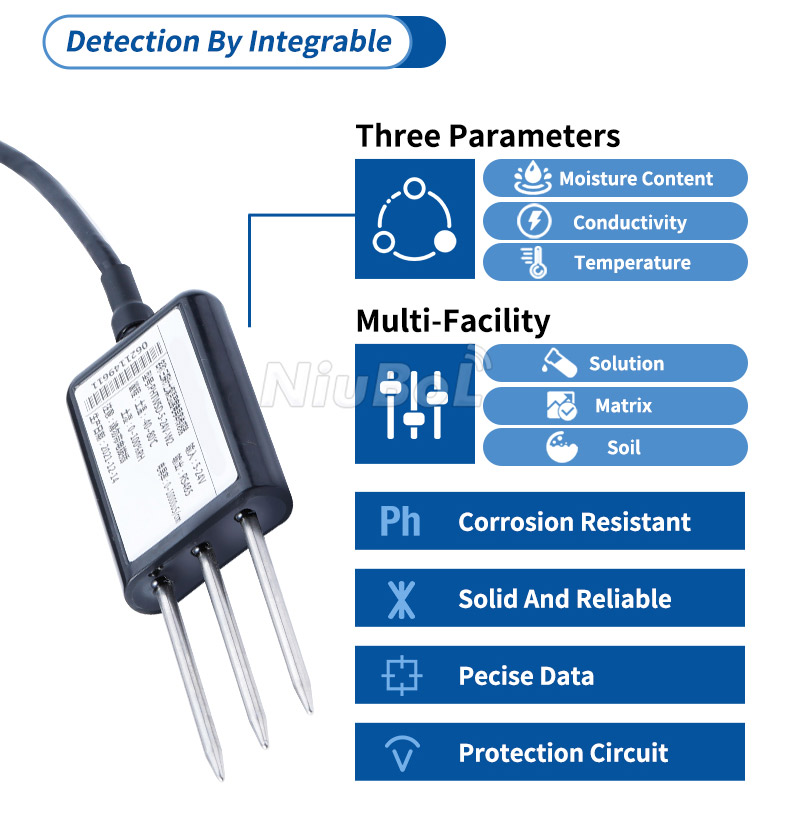
1. Measuring range and accuracy: Select sensors with appropriate measuring range and accuracy according to actual needs.
2. output mode: according to the needs of the data acquisition system to choose the appropriate output mode (such as 485 output, 4 ~ 20mA, etc.).
3. Working environment: Consider the working temperature, humidity and other environmental factors of the sensor to ensure that it can work properly in the target environment.
4. Durability: Select sensors with rugged and durable housings and rust-proof, salt and alkali corrosion-resistant probes to adapt to a variety of soils and harsh environments.
5. Intelligence and integration: Consider whether the sensor has intelligent functions and the ability to integrate with other equipment to meet the needs of future smart agriculture.
1. real-time monitoring and early warning: the use of soil moisture sensors to monitor soil moisture content in real time, when the soil moisture reaches the set threshold triggers an early warning signal to remind farmers to irrigate.
2. accurate irrigation: according to the soil moisture sensor data to develop a precise irrigation plan, to avoid overflooding and water shortages, improve water use efficiency.
3. Automation control: Combine with IOT technology to realise the automation control of the irrigation system, automatically adjusting the irrigation amount, irrigation time and irrigation method and other parameters according to the data from the soil moisture sensor.
4. Data analysis and optimisation: Long-term analysis and processing of soil moisture sensor data to discover the relationship between crop growth and soil moisture, further optimising irrigation practices and improving crop yields.
5. Zoning management: Soil conditions may be different in different areas of the field, and the sensor enables zoned irrigation and targeted management.
6. Incorporating weather forecasts: Adjusting irrigation schedules in conjunction with future weather forecasts to avoid irrigating when rain is imminent.
7. Data-driven decision-making: Continuously collected soil moisture data can be used for analysis to optimise irrigation strategies, such as the use of water-saving irrigation techniques such as drip or micro-sprinkler irrigation.
8. Long-term monitoring and analysis: Long-term recording of data to analyse water demand patterns during the crop growth cycle, providing a scientific basis for future planting.
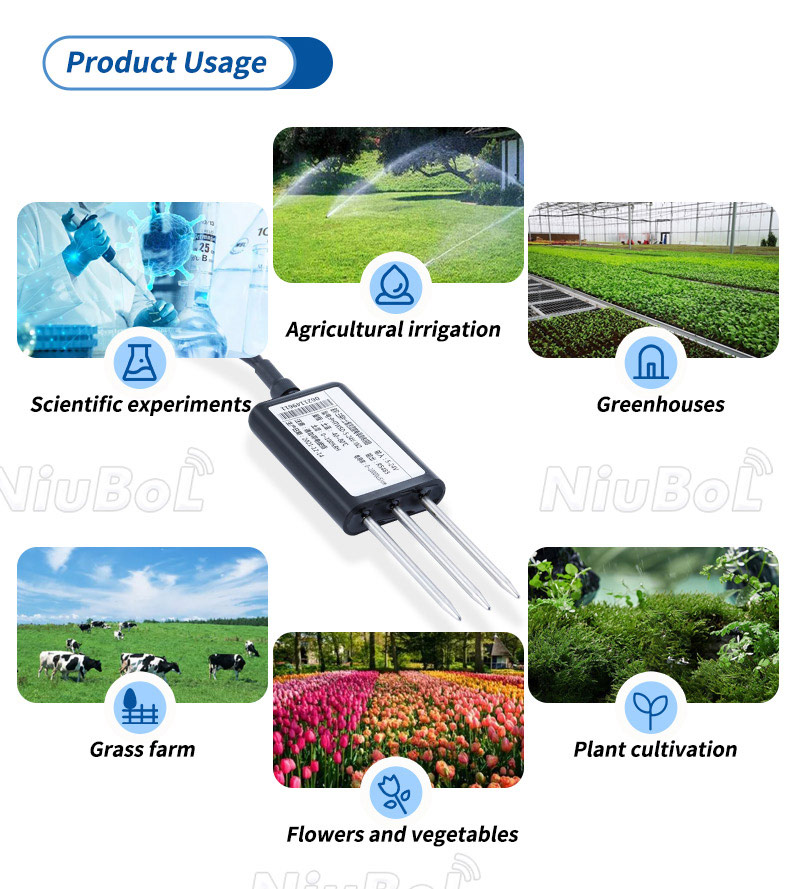
Summary
Soil moisture sensors for agriculture are one of the core tools of modern precision agriculture, which enables precise control of soil moisture through high-tech monitoring means. These sensors not only enhance the efficiency and accuracy of irrigation, but also promote the sustainable development of agricultural production, achieving a win-win situation for both environmental and economic benefits. Through the proper selection and use of sensors, farmers can optimise their agricultural irrigation practices to improve crop yields and quality, while conserving water and reducing production costs.
1.NBL-S-THR Soil Temperature Moisture Sensor datasheet
NBL-S-THR-Soil-temperature-and-moisture-sensors-Instruction-Manual-V4.0.pdf
2. NBL-S-TMC Soil Temperature Moisture EC Sensor datasheet
NBL-S-TMC-Soil-temperature-and-moisture-conductivity-sensor.pdf
3. NBL-S-TM Soil Temperature Moisture Sensor datasheet
NBL-S-TM-Soil-temperature-and-moisture-sensor-Instruction-Manual-4.0.pdf
4. NBL-S-TMCS Soil Temperature, Moisture, Conductivity and Salinity Integrated Sensor
NBL-S-TMCS-Soil-Temperature-Humidity-Conductivity-and-Salinity-Sensor.pdf
5. NBL-S-TMCS-7 Soil Temperature, Moisture, NPK, Conductivity and pH Integrated Sensor
7-in-1-Soil-Composite-Sensor-Manual.pdf
4. NBL-S-TMCS-8 Soil Temperature, Moisture, NPK, pH, Conductivity and Salinity Integrated Sensor
Related recommendations
Sensors & Weather Stations Catalog
Agriculture Sensors and Weather Stations Catalog-NiuBoL.pdf
Weather Stations Catalog-NiuBoL.pdf
Related products
 Combined air temperature and relative humidity sensor
Combined air temperature and relative humidity sensor Soil Moisture Temperature sensor for irrigation
Soil Moisture Temperature sensor for irrigation Soil pH sensor RS485 soil Testing instrument soil ph meter for agriculture
Soil pH sensor RS485 soil Testing instrument soil ph meter for agriculture Wind Speed sensor Output Modbus/RS485/Analog/0-5V/4-20mA
Wind Speed sensor Output Modbus/RS485/Analog/0-5V/4-20mA Tipping bucket rain gauge for weather monitoring auto rainfall sensor RS485/Outdoor/stainless steel
Tipping bucket rain gauge for weather monitoring auto rainfall sensor RS485/Outdoor/stainless steel Pyranometer Solar Radiation Sensor 4-20mA/RS485
Pyranometer Solar Radiation Sensor 4-20mA/RS485
Screenshot, WhatsApp to identify the QR code
WhatsApp number:+8615367865107
(Click on WhatsApp to copy and add friends)
